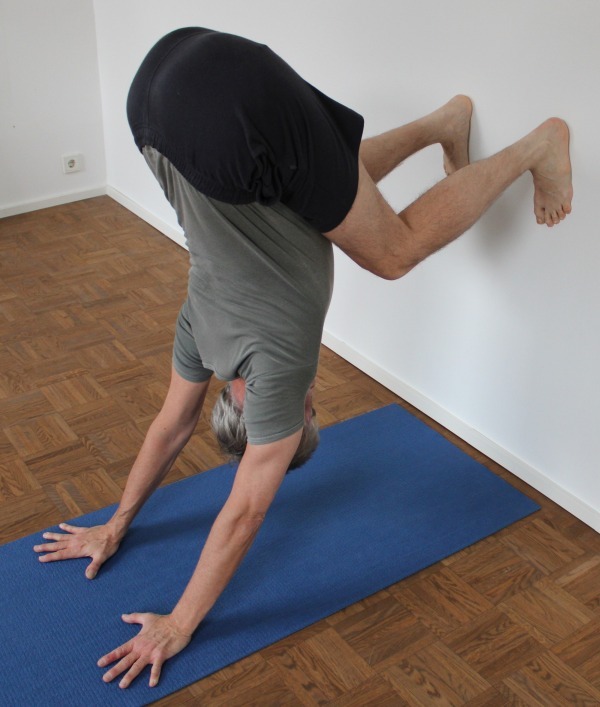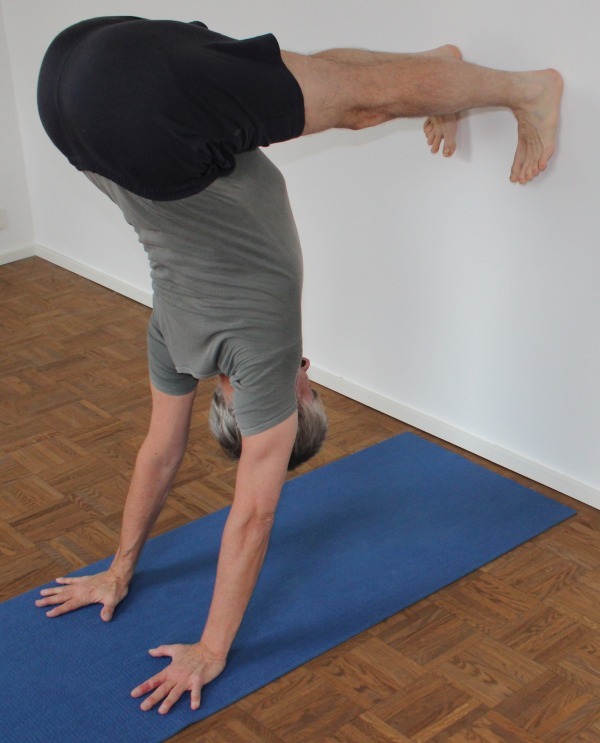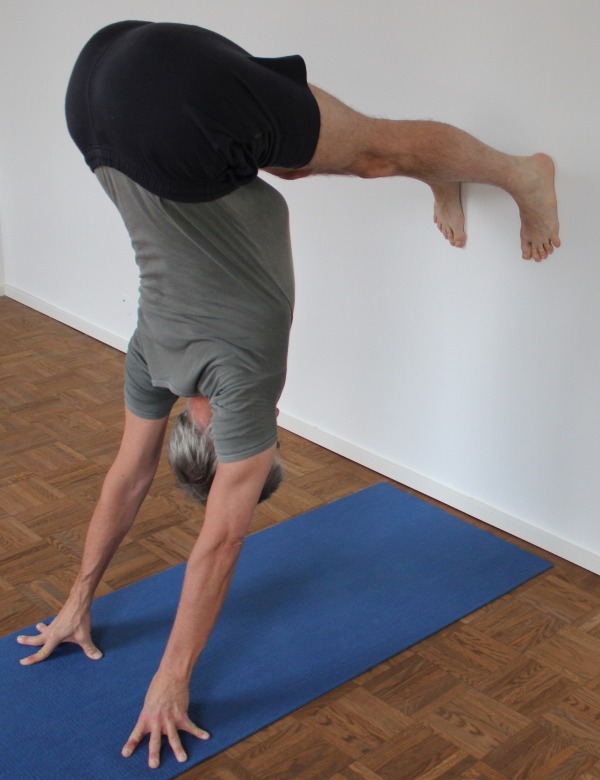- Sit in front of a wall, the feet facing the ceiling, legs stretched against the wall.
Lift a buttock and place a finger or thumb on the floor where the ischial
bone was before. Get halfway up by turning around and standing on your feet.
Place both hands shoulder-wide on the floor so that the wrists stand at
the distance from the wall marked with your finger.
- Spread your fingers, stretch your arms, apply even pressure to all parts of
your hands and move your shoulders and chest towards the wall behind you.
- Lift one foot up and place it on the wall, possibly only the undersides
of your toes and balls of foot, about the height of the pelvis
- Shift your body weight more towards your hands until the foot remaining on the
ground becomes light and can be easily lifted off the ground without swing.
Increase the movement of the chest and shoulder to the wall behind you.
- Lift up the foot that has remained on the floor and place it at a hip-wide
distance next to the foot that is already on the wall.
- stretch the knees, against the resistance offered by the muscles on the
back of the leg, trying to keep shoulders and chest close to the wall
- Check the stretching of the arms and stretch them again if necessary.
- Stretch from the shoulders to move the upper body as far away as possible from the ground.
- Turn out the arms as far as possible, i. e. turn the biceps away from the wall
without the inner hands, the radial finger joints or the proximal finger
joints lifting off from the ground or losing their pressure.
|
- The ability to further exorotation of the arms is naturally very limited
at an angle of about 180° frontal abduction. Furthermore, there is a connection
between the exorotation or even the attempt to do this and the reduction of
pressure in the radial finger joints, radial proximal finger joints and the
entire inner edge of the palm. See the corresponding preliminary exercises.
- In case of a lack of ability to press the (in particular radial) finger joints
(especially of the index finger and middle finger) strongly on the floor,
whether it is due to pain sensation in the palmar flexors of the wrist,
which are already sufficiently stressed by stretching, or due to a lack of
strength or lack of body consciousness, pain or a feeling of cramping
in the dorsal wrist easily arises. With only a few exceptions,
these are a consequence of the first mentioned causes.
In contrast to downface dog, in which the problem hardly arises and the
upface dog, in which they may very well occur, because the outer angle in
the wrist is much smaller and close to the physiological limit,
they are more pronounced here, since generally speaking the entire body
weight rests on the hands.
- When working with the focus of the work in the hands, in many participants we
see a tendency to work with weight shift, i. e. by moving the shoulder away
from the wall, or with rotation of the arm (endorotation, which increases the
momentums in the radial wrist area). Both must be strictly avoided. The
pressing down of the radial metacarpophalangeal joints may only be done
by force of the palmar flexors in combination with the pronators of the hand.
- The movement of the shoulders and chest towards the wall, provided that the
hands are sufficiently close to the wall, is the only guarantee that the
feet do not lose their grip on the wall and drop or slide to the floor.
With increasing force, with which the chest is moved to the wall,
the pose becomes more stable. Assistance from the outside by a
second person can be of great importance in order to give the
practitioner the necessary feeling for the pose and activity
(see corresponding partner exercise).
- Of course, the movement of the shoulder area towards the wall increases
the limitation in the ability to exorotate the arms. On the other hand,
the ability to push the finger's metacarpophalangeal joints onto the floor
does not increase to the extent expected, as the movement of the thorax
to the wall increases the dorsal outer angle of the wrist,
nor are the structures on the dorsal side of the wrist relieved
by the movement in a comparable extent
- If there is a tendency to cramp in the cranial trapezoidal portion, it can be
helpful to support the exorotation of the arms from the outside by another person.
- The distance of the wrists from the wall is probably the most important parameter
of this posture, besides the force with which the chest is moved to the wall.
It plays a decisive role in the quiestion whether the pose can be taken and
how long it can be kept, as well as in determining how intensive the stretching
of the muscles in the shoulder joints are. If the distance is too small,
the posture can hardly be kept for a few seconds. If the shoulders are further
away from the wall than the wrists, the distance must be considered too small
except in cases of very strong deltoid muscles, which can keep the angle in the
shoulder joint stable for a sufficiently long time. If the distance of the
wrists from the wall is too large, too little meaningful activity can be
developed in the pose. In cases of sufficiently flexible shoulders with regard
to frontal abduction, this poses a risk that the shoulder ligament structures
may be strained if there is no longer any muscular stretching and - if the
distance is too large - the weight of the entire upper body, head and legs
is converted into moments in the shoulder joint which may have a destructive
effect on the ligaments instead of stretching muscles. However, as long as the
shoulders are at least as far away from the wall as the wrists, this danger
will not occur. If the shoulders are closer than the wrists and thus the
arms are clearly tilted towards the ground, this danger increases and more
attention must be paid to stretching out of the shoulders and the exorotation
of the arms. Especially the latter is very important, as can be seen from the
exact run of the muscles, which are mainly to be stretched.
- Of course, as for similar postures, the connection between the occuring
endorotation of the upper arms, lack of stretching in the elbows and lateral
abduction of the arms in the shoulders applies. All three factors are
evasive movements that occur as a result of reduced flexibility in the
shoulders and all the more so as the frontal abduction goes around 180°,
and can only be prevented with great effort or must be weighed against each other.
- Keep the feet on the wall hip-wide and parallel (referring to their centerline)
pointing downwards. Ideally, the heels and sitting bones are at the same
height, so that the back of the leg is approximately horizontal.
For people who are much more flexible in the ischiocrural group,
the feet can be set lower and for those who are significantly
less flexible, respectively, may be set higher, without causing
any noticeable loss of effect of the pose. With reduced flexibility,
the feet can also be positioned further apart from each other as
hip wide if the distance of the feet from the floor required for
an appropriate pose would mean that the heels would no longer stand on the wall.
- in the pose move especially the inner knees upwards and push the entire legs
upwards towards the ceiling (see corresponding variant with raised forefeet).
- Concerning the feet, the emphasis is on the pressure on the heels,
not on the balls of the feet.
- In this position, stretch out of the shoulders as far as possible.
In contrast to poses such as downface dog'or urdhva hastasana, this poses
a much greater challenge due to the much heavier weight to be moved and maybe,
leads to noticeable fatigue of the musculature.
- perform the maximum possible flexion in the hips to facilitate or at least not
further suppress the movement of the upper body towards the wall.
Decreased flexion can have a restrictive effect on the movement in the
shoulders via the back muscles. Often it can be observed that with support
of the flexion movement in the hips by a partner, a movement in the
shoulder to the wall results. The ischial bone moves apart
(as well as the legs) and away from the wall in the pose.
- People who are quite flexible in the shoulder can possibly position their
hands much closer to the wall than the ischial bones are at a distance
from the wall. This may lead to an upper body back bend. This is considered
to be uncritical, except in some cases of lower back disorders. If this
is the case, move the pelvis slightly out of the maximum flexion without
bringing the upper body out of the good (close to the wall) position.
- The more flexible the shoulders are and the more the upper body can be moved
towards the wall, the more important it is to pay attention to the maximum
exorotation or to further improve it so that the ligament structures in the
shoulder are not strained when the possibility of muscular stretching had come
close to its end.
- Overstretching of the arms must be absolutely avoided if it a) exceeds a
dimension of approx. 3° or b) leads to pain sensation in the joint gap of
the elbow joint on the stretching side. Until forther notice the method of
choice is the use of the m. biceps brachii (reps. the arm's flexor group), which
is the only one that can safely neutralize the overstretching momentums in
the elbow joint. As a rule, you will find the arm biceps inactive in almost
all practioneers, unless you work with this focus, which is quite acceptable,
because the gravity induced bending momentum has to be compensated and
every force that would be applied in the elbow joint by the biceps would
additionally have to be neutralized by the m. triceps brachii, which is
already busy enough. If there is a inclination to overstretch the
elbow joints, however the use of the biceps must be trained so that
the angle can be set as precisely as possible to 180° from a conscious
balance of force, so that gravity can be directed as precisely as
possible through the elbow joint. Working with the arm biceps in the
stretched position of the elbow joint is often not easily accessible,
so that corresponding preliminary exercises for the individual requirements
of the rectangular handstand, which are sometimes pronounced, are recommended.
- The position of the head is, as might be expected, stretched to the ground.
The gaze to the hands would not be appropriate in two ways, firstly,
because anyway a tendency to cramp the neck exists and this would be
increased in many people and secondly, because this movement is associated
with the opposite movement of the arms (in the direction of frontal adduction)
than is required. Instead, the head can slightly be moved towards the upper
part of the body with the gaze turned towards the feet, if this is
experienced as supporting the movement in the shoulders. Sometimes,
in cases of tense neck musculature, a repeated change between moderate
flexion and reclination of the head can be perceived as soothing.
- if possible, do not use rectus femoris for flexion in the hips,
otherwise the rectus femoris may develop a tendency to cramp because
of the stretched knees.
- in rather rare cases, the pose leads to an unpleasant hollow back sensation.
This is usually the case with barely flexible shoulders, but with a fairly flexible
leg back. The hands can then not be positioned so far in the direction of the
wall that there is a uniform curvature of the back from the lumbar spine to
the upper lumbar spine, but a distinct hyperlordosis develops in the lumbar spine.
This is usually remedied by a deeper position of the feet on the wall,
which brings the hips closer to the limit of flexibility of the ischiocrural
group and thus the lumbar spine closer to the vertical and the physiological lordosis.
| known issues that may occur even when practicing correctly | - pain in the lumbar spine
In rare cases of a very flexible ischiocrural group and very immobile shoulders, this constellation can result in a clear hyperlordosis of the lumbar spine with corresponding sensation.
|
|












